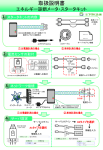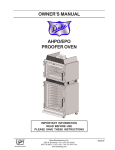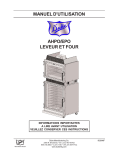Download Duke 6/13 Specifications
Transcript
6/13 &"E"Series
GAS FIRED CONVECTION OVEN
Installation, Operation, Parts
& Maintenance Manual
Duke Manufacturing Co.
2305 N. Broadway • St. Louis, Missouri
800-735-3853 • 314-231-1130 • Fax 314-231-5074
www.dukemfg.com
153810Q
INDEX
6/13 & "E" Series Gas Specifications
PAGE
3
Installation Instructions
A. Qualified Personnel
B. Delivery & Inspection
C. Location of Oven
D. Gas Piping
E. Electrical Connections
F Ventilation
G. Gas Oven Assembly
H. Adjustments Associated with Installation
I. Double Stack Ovens
4
4
4
5
6
6
6-7
7
8
Operating Instructions
A. Oven Controls
B. General Guidelines for Operation
C. Suggested Times & Temperatures
D. Cleaning the Oven
9
10 - 12
13
14
15
Maintenance Instructions
A. Adjustments
B. Door Adjustment
C. Door Switch Adjustment
D. Thermostat Calibration
E. Gas Pressure Regulation & Adjustment
F. Venting System
Repair Parts List
16
15
15 - 16
16
17
17
18
Door Assembly
19
“V” Controller Assembly
“XX Controller Assembly
20
21
Wiring Diagram
22
Please supply the ID Number and the Serial Number when ordering replacement parts or
requesting service. We recommend service by Duke Authorized Service Agencies during and
after the warranty period.
Duke Manufacturing Co.
2305 N. Broadway • St. Louis, Missouri
800-735-3853 • 314-231-1130 • Fax 314-231-5074
www.dukemfg.com
2 of 22
POST IN A PROMINENT LOCATION:
Instructions to be followed in the event the user smells gas. This information shall
be obtained by consulting the local gas supplier.
FOR YOUR SAFETY:
Do not store or use gasoline or other flammable vapors or liquids in the vicinity of
this or any other appliance.
WARNING:
Improper installation, adjustment, alteration, service or maintenance can cause
property damage, injury or death. Read the installation, operating and maintenance
instructions thoroughly before installing or servicing this equipment.
“E” & 6/13 SERIES GAS CONVECTION OVEN
Specifications
NATURAL GAS
1000 BTU
HEATING VALUE
0.63
SPECIFIC GRAVITY
GAS PRESSURE AT
3.5" W.C
MANIFOLD
PROPANE GAS
2550 BTU
95.0 MJ/m3
0.63
1.53
1.53
0.87 kPa
10" W.C.
2.49 kPa
37.3 MJ/m
3
OVEN INPUT STANDARD DEPTH
PER BURNER
PER OVEN
20,000 BTU/HR
5.9 kW
20,000 BTU/HR
5.9 kW
40,000 BTU/HR
11.8 kW
40,000 BTU/HR
11.8 kW
23,000 BTU/HR
6.8 kW
23,000 BTU/HR
6.8 kW
46,000 BTU/HR
13.5 kW
46,000 BTU/HR
13.5 kW
OVEN INPUT DEEP DEPTH
PER BURNER
PER OVEN
BURNER ORIFICE SIZE
STANDARD DEPTH
DEEP DEPTH
#44
2.18mm
#55
1.32mm
#43
2.26mm
#54
1.40mm
Duke Manufacturing Co.
2305 N. Broadway • St. Louis, Missouri
800-735-3853 • 314-231-1130 • Fax 314-231-5074
www.dukemfg.com
3 of 22
INSTALLATION INSTRUCTIONS:
A. Qualified Personnel
These installation instructions are for the use of qualified
installation and service personnel only. Installation or
service by other than qualified personnel may result in
damage to the oven and/or injury to the operator.
Qualified installation personnel are those individuals,
firms, companies or corporations which either in person
or through an agent is engaged in and responsible for:
• The installation or replacement of gas piping or the
connection, installation, repair or servicing of
equipment, who are experienced in such work,
familiar with all precautions required, and have
complied with all requirements of state and local
authorities having jurisdiction. See: National Fuel
Gas Code NFPA 54 (ANSI Z223.1).
• The installation of electrical wiring from the electric
meter, main control box or service outlet to the
electrical appliance. Qualified installation personnel
must be familiar with all precautions required and
have complied with all requirements of state and
local authorities having jurisdiction. See: National
Electrical Code, ANSI/NFPA70.
The installation must conform with local codes, or in the
absence of local codes, with the National Fuel Gas Code,
ANSI Z223.1/NFPA 54, or the Natural Gas and Propane
Installation Code, CSA B149.1 as applicable, including:
• The appliance and its individual shutoff valve must
be disconnected from the gas supply piping system
during any pressure testing of that system at test
pressures in excess of ½ psi (3.5 kPa).
• The appliance must be isolated from the gas supply
piping system by closing its individual manual
shutoff valve during any pressure testing of the gas
supply piping system at test pressures equal to or
less than ½ psi (3.5 kPa).
For an oven equipped with casters, the installation shall
be made with a connector that complies with the Standard
for Connectors for Movable Gas Appliances, ANSI
Z21.69/CSA 6.16 and a quick-disconnect device that
complies with the Standard for Quick-Disconnect Devices
for Use with Gas Fuel, ANSI Z21.4/CSA 6.9. When
installing the oven with casters and quick-disconnect
hose, adequate means must be provided to limit the
movement of the oven without depending on the
connector and the quick disconnett device or its
associated piping to limit the oven movement. Restraining
means may be attached to the vertical portion of the base
frame in the rear of the oven.
B. Delivery and Inspection
Duke Manufacturing Co. does everything within its power
to insure you received your oven in good condition. They
are strapped down on heavy wooden skids and surrounded
by heavy "tri-wall" cartons to prevent shipping damage.
They have all been carefully inspected before they were
packaged and consigned to the carrier.
Upon delivery of your Duke oven:
• Look over the shipping container, carefully noting
any exterior damage on the delivery receipt, which
must also be signed by the driver/ delivery person.
• Uncrate and check for any damage, which was not
evident on the outside of the shipping container.
This is called concealed damage. The carrier must
be notified within fifteen (15) days of the delivery of
the oven and the carton, skid and all packaging
materials must be retained for inspection.
Duke Manufacturing Co. cannot assume liability for loss
or damage suffered in transit. The carrier assumes full
responsibility for delivery in good order when the
shipment was accepted. However, we are prepared to
assist you in filing your claim.
C. Location of the Oven
Proper planning and placement of the oven will give you
the best results in terms of long-term user convenience
and satisfactory performance. We urge you to give
adequate thought in the placement of your oven prior to
its arrival.
• The oven should be placed in an area that is free
from drafts and accessible for proper operation and
servicing.
• The area around the oven must be kept clear of
combustible materials. A minimum clearance of:
RIGHT SIDE
LEFT SIDE
REAR
FLOOR
Combustible
1"
1"
3"
8"
NonCombustible
0”
0”
3”
8”
must be maintained between the oven and any
combustible or non-combustible surface.
Duke Manufacturing Co.
2305 N. Broadway • St. Louis, Missouri
800-735-3853 • 314-231-1130 • Fax 314-231-5074
www.dukemfg.com
4 of 22
This oven has been tested and certified for use on gas
systems that do not exceed 1/2 psi (3.45 kPa) of pressure.
If the piping system is tested at a pressure higher than 1/2
psi (3.45 kPa), this oven should be isolated from the
supply by disconnecting it. If the piping system is tested
at a pressure lower than or equal to 1/2 psi (3.45 kPa),
this oven should be isolated from the supply by shutting
off the manual shut off valve located on the front panel.
D. Gas Piping
Each section of the "E" Series or 6/13-G Ovens (standard
depth) is rated at 40,000 BTU's per hour (11.7 kW) or
(deep depth) 46,000 BTU's per hour (13.5 kW).
Therefore, 38-40 (standard), 44-46 (deep) cubic feet of
natural gas or 16 (standard), 18.4 (deep) cubic feet of
propane gas per hour must be supplied to each unit
(stacked units count as two) when the oven is full on. In
order to achieve the degree of performance for which the
unit has been designed, the overall piping plan of the
kitchen, properly sized, is essential. The installation of
this oven must conform with all local codes, or in the
absence of any local codes, to the National Fuel Gas
Code, NFPA 54 and ANSI Z 223.1.
Your local gas supplier should consult the National Fuel
Gas Code for proper sizing and installation of gas piping.
Generally, piping should be sized to provide a gas supply
sufficient to meet the maximum demand of all gas
appliances on a line without undue loss of pressure at the
outlet to the equipment. The total BTU requirements of
the equipment being served and the length of the piping
from the meter to the appliances are major considerations
in the proper design of the gas supply system.
MAXIMUM CAPACITY OF IRON PIPE IN CUBIC FEET PER
HOUR (PRESSURE DROP OF 0.5" W.C.) NATURAL GAS
MAXIMUM CAPACITY OF PIPE IN
THOUSANDS OF BTU'S PER HOUR OF
UNDILUTED PROPANE GAS AT 11" W.C.
Length in Feet
1/2"
3/4"
1"
1.1/2"
2"
Length
in Feet
1/2"
3/4"
1"
10
175
360
680
2100
3950
10
275
567
1071
20
120
250
465
1460
2750
20
189
393
732
30
97
200
375
1180
2200
30
152
315
590
40
82
170
320
990
900
40
129
267
504
50
73
151
285
900
1680
50
114
237
448
60
66
138
260
810
1520
60
103
217
409
70
61
125
240
750
1400
70
96
196
378
80
57
118
220
690
1300
80
86
185
346
90
53
110
205
650
1220
90
83
173
322
100
50
103
195
620
1150
100
78
162
307
From National Fuel Gas Code
From National Fuel Gas Code
Duke Manufacturing Co.
2305 N. Broadway • St. Louis, Missouri
800-735-3853 • 314-231-1130 • Fax 314-231-5074
www.dukemfg.com
5 of 22
E. Electrical Connections
Vapors from Commercial Cooking Equipment, NFPA-96".
Your oven is supplied for connection to a 115 volt, single
phase grounded circuit. The electric motor, oven lights,
indicator lights and control circuits are connected through a
seven-foot electric supply cord found at the rear of the
oven.
Direct Flue Venting
Before making any connections to these units, check the
rating plate to assure that the voltage and phase of the oven
is compatible with the electrical supply. When installing,
all ovens must be electrically grounded in accordance with
local codes, or in the absence of local codes, with the
National Electrical Code, ANSI/NFPA 70 (in Canada CSA Std. C22.2). Wiring diagrams are located in the
control compartment area of the oven. Standard wiring
schematics are also provided with this manual.
WARNING:
This appliance is equipped with a three-prong
(grounding) plug for your protection against shock
hazard and should be plugged directly into a properly
grounded three-prong receptacle. DO NOT cut or
otherwise remove the grounding prong from this plug.
F. Ventilation
Proper ventilation is very important for the proper function
of your oven. A good ventilation system will allow the
oven to function properly as well as remove unwanted
vapors and products of combustion. Not venting the ovens
properly can result in unsatisfactory baking results as well
as the possibility of damaging your oven. To keep your
warranty in force, a proper ventilation system must be
employed, either direct vented or under a canopy.
Venting to a Canopy Exhaust Hood
The best way to vent your oven is by placing it under a
properly designed mechanically driven exhaust hood. The
hood should be sized so the equipment that it is designed to
ventilate fits underneath with a minimum six (6) inch (152
mm) overhang on all sides not adjacent to a wall. The
distance from the floor to the lower edge of the canopy
should not exceed seven (7) feet (2.2 m).
The hood should have adequate capacity and provide a
sufficient supply of make- up air. Ventilation hoods come
in many sizes and capacities. Hood capacity is expressed in
cubic feet per minute (CFM). The total make-up and
exhaust air required for the canopy hood should be about
22 CFM per oven section. Information for the proper
construction and installation of ventilating hoods may be
obtained from the "Standard for the Installation of
Equipment for the Removal of Smoke and Grease-Laden
Occasionally it is not possible or practical to install a
powered canopy hood. In those cases the oven can be
vented directly by means of a direct flue method. Correctly
venting your oven is very important to insure proper
cooking results and preclude any premature failures in the
burner or burner compartment. The direct flue method
incorporates a drafthood that is mounted to the top of the
oven (or the upper oven section in a stacked unit). The flue
then rises from the drafthood vertically to a point 6-8 feet
above the roof or any close structure. The flue is then
capped with an approved vent cap to isolate the flue from
the external environmental conditions.
The direct flue method does not incorporate the ability to
replace air consumed by and vented from the oven. An
adequate supply of room make-up air must be provided if
your oven is to be vented by this method. The total
makeup air requirement for one oven section is
approximately 30 CFM.
Lighting Instructions:
• Turn Gas Shut Off to ON Position
• Turn Power Switch to COOK Position
• Set Thermostat to Desired Temperature
Shut Down Instructions:
• Turn Power Switch to OFF Position
• Wait 5 Minutes Before Relighting Oven
WARNING:
Keep the oven area free and clear from combustibles.
Note: This manual must be retained for future
reference.
G. Oven Assembly
Before assembling and installing the oven, please check to
make sure that all necessary parts are present. In addition
to the oven itself, there will also be legs, feet or casters, the
flue/vent guard or drafthood & drafthood collar assembly,
(for double sections, retaining clips, flue riser and/or
common manifold) and miscellaneous hardware. Please
check the interior of all oven sections for the parts needed
to assemble and install your oven(s).
Leg Attachment
• Once the oven has been removed from the carton, lay
it on its left side (the side without the controls), hold
the leg and align with the threaded holes in the front
comer of the bottom of the oven. Carefully start the
threads of the comer leg bolt (5/16"-18 X 1/2"),
Duke Manufacturing Co.
2305 N. Broadway • St. Louis, Missouri
800-735-3853 • 314-231-1130 • Fax 314-231-5074
www.dukemfg.com
6 of 22
avoid cross threading.
• Align the leg plate holes in each leg with those in the
corners of the oven bottom and secure using two 5/
16"-18 x 1/2" bolts. Tighten all bolts firmly. Repeat
this procedure for all legs.
• Raise the oven up on its legs.
Level the oven by turning the adjustable feet in or out as
needed.
Caster Installation
• Casters are available as an option for both the single
and double oven sections.
• The installation of casters requires the removal of
the adjustable feet from the legs. This is done by
placing the bit of a large screwdriver against the lip
of the foot and rapping the screwdriver to drive the
foot out of the leg. The caster is then inserted fully
into the opening where the foot came out and the
locking nut tightened to expand the compression
sleeve of the caster.
NOTE: The casters with locking brakes are best
mounted on the front side of the oven for easier access.
considered defects, rather a normal and routine part of the
proper installation of the equipment.
These adjustments include but are not limited to:
• Adjustments and recalibration of the thermostat
• Adjustment to the doors.
• Burner or pilot adjustment.
• Adjustments to the gas pressure regulator.
• Leveling, and tightening of fasteners.
No installation should be considered complete without
proper inspection and, if necessary, any adjustments by
qualified service or installation personnel.
It is also important not to obstruct the natural flow of
combustion and ventilation air if the oven is to operate
properly. This oven should not be installed on a curb base
or sealed to the wall. Either condition can restrict the flow
of air to the combustion compartment or prevent proper
ventilation of the blower motor. The blower motor has a
thermal protection device that will trip because of
excessive ambient temperature at the back of the oven.
This condition should be corrected immediately to avoid
damaging the oven permanently.
NOTE: If you plan to use casters and flexible fuel gas
connectors, a fixed restraint of the proper length must
be incorporated to secure the oven to a non-movable
surface to eliminate strain on the connector. If the oven
is removed from its normal position, the restraint must
then be reattached when returned.
Before making any connections to the oven, check the
ratings plate to be sure the oven specifications concur with
the type of gas and voltage to be supplied to the oven.
Installation of the Vent
The plate bearing the oven's serial number is attached to
the underside of the upper ledge above the control panel.
• Ovens ordered for installation under a powered
canopy exhaust hood should have the flue guard in
place. This item can be installed by placing it over
the flue opening, making sure that it does not
obstruct the flue, and attaching it with the screws
provided.
• Ovens ordered for installation in a location other than
under a powered canopy exhaust hood are supplied
with a drafthood & drafthood collar. This device
mounts to the top of the upper oven section by
attaching the drafthood adapter to the flue opening
with the screws provided, the drafthood is then
mounted on top of the adapter. The flue pipe is
attached vertically to the drafthood.
H. Adjustments Associated with Installation
Each oven section and all its component parts have been
tested thoroughly and inspected before your oven was
shipped from the factory. However, it is sometimes
necessary to further test or adjust the oven once it has been
installed. Such adjustments are the responsibility of the
Dealer or Installer. These types of adjustments are not
The rating plate is located behind the lowered lower front
panel. To access, loosen the four screws below the doors,
and pull panel outward.
I. Double Sections
• Secure the short legs to the bottom of the lower
section as described in previous section.
• Casters are installed by the method described for
single section ovens. Previous section.
• Place upper section on top of lower section and align
all edges of the ovens.
• Locate securing clips and align with holes on rear
frames of oven section, install three screws each as
provided and tighten.
• At the rear of the oven, install the flue connector by
sliding it up through the flue vent opening in the top
of the oven and over the upper flue vent. Push it
flush with the back of the oven then slide it down
over the lower flue vent. Attach with screws
provided.
• Install flue guard or drafthood adapter, drafthood and
drafthood collar to upper section.
See drawing on next page.
Duke Manufacturing Co.
2305 N. Broadway • St. Louis, Missouri
800-735-3853 • 314-231-1130 • Fax 314-231-5074
www.dukemfg.com
7 of 22
MOUNTING FLUE EXTENSION TO TOP OVEN.
1.) Remove existing flue trim from the top of
oven.
st
2.) Insert flue extension thru top opening 1 and
then align holes on flue extension with holes
on rear panel of oven.
3.) Use 6 of the 8 screws 10-24x1/2” hex washer
head that are provided to attach the flue
extension to the rear panel of the oven as
shown in figure. The other 2 screws are
extras and are not used.
4.) Re-install the existing flue trim.
SECURING DOUBLE STACKED OVENS
1.) On rear of top oven remove two existing screws
that attach the side panel to the base.
2.) On rear of bottom oven remove one existing
screw that attaches the top to the side panel.
3.) Install stacking bracket using the existing
screws as shown in figure.
nd
4.) Repeat steps to install 2 stacking bracket on
other side
Duke Manufacturing Co.
2305 N. Broadway • St. Louis, Missouri
800-735-3853 • 314-231-1130 • Fax 314-231-5074
www.dukemfg.com
8 of 22
OPERATION INSTRUCTIONS
The information in this section is intended for the use of
qualified operating personnel. Qualified Operating
Personnel are those individuals who have carefully read
the information contained in this manual, are familiar
with the function of the oven and/or have had experience
with operating the equipment described. We recommend
following these instructions to insure optimum
performance, long life and trouble-free service from your
oven.
The "E" & 6/13 Series of Convection Ovens
Convection cooking has been around from the 1960s. Its
advantages are well known. It differs from conventional
cooking by the movement of heated air within the
cooking cavity by means of a fan. This moving, heated air
helps to strip the cool air from around the product being
cooked, allowing the heat to penetrate more rapidly. The
results are that your product is cooked quicker and at a
lower temperature with the comparable product quality
found in conventional ovens.
The "E" & 6/13 Series of ovens represent the very latest
in energy efficiency technology with an appreciable
reduction in NOx emissions over other gas fired ovens, both
convection and conventional. The introduction of heat
directly to the cooking cavity precludes any undue thermal
loss due to the venting away of heated air before it has
utilized its energy to cook product. This results in lower flue
temperatures and hence, less heat loss to your kitchen so
your exhaust and air conditioning systems do not work as
hard. Also, the "over-sized" cooking cavity allows you to
cook more products in each load.
All of this in addition to superior cooking results means the
"E" & 6/13 Series of gas fired convection ovens are
outstanding values. In addition, lower NOx emissions
means it's environmentally friendly. Please take the time to
carefully read the operating instructions. They are important
in the successful use of your oven.
WARNING:
The "E" & 6/13 Series Convection Ovens rely on
electricity for powering the ignition system and the fan.
Do not attempt to operate during a power failure.
Duke Manufacturing Co.
2305 N. Broadway • St. Louis, Missouri
800-735-3853 • 314-231-1130 • Fax 314-231-5074
www.dukemfg.com
9 of 22
“V” Controller
A. Oven Controls —
Electro-Mechanical
• 1. The Power Switch - Controls power to ON or
Cool Down Function.
• 2. The Indicator Light - When lit indicates burners
are operating. When the light goes out, the oven
has reached its cooking temperature.
• 3. The Cooking Thermostat - Controls the oven
temperature.
• 4. The Cooking Timer - Sounds an electric buzzer
on expiration of operator set time as a reminder
to remove product at end of cooking cycle.
• 5. The Light Switch (Optional) - Controls interior
lights.
• 6. The Fan Speed Switch (Optional) - Sets fan
speed to high or low.
• 7. The Manual Gas Shut Off Valve - Turns gas
supply to oven controls on or off.
Duke Manufacturing Co.
2305 N. Broadway • St. Louis, Missouri
800-735-3853 • 314-231-1130 • Fax 314-231-5074
www.dukemfg.com
10 of 22
Operating Instructions
“V” Controller
Timer Resolution
The Timer displays time from 0 to 60 minutes, in oneminute increments.
Temperature Scale
The Temperature Control displays the temperature in °F.
The temperature range is from 150°F - 500°F, in 25°F
increments.
Cool Down
This feature enables the oven to be cooled rapidly by
allowing the fan to operate with the burners turned off.
To activate, turn the Power Switch to the COOL position
and open the oven door. When the door is opened
enough to disengage the door switch, the fan will turn on.
Closing the door will turn the fan off.
Fan Speed Switch
The fan speed can be set to high or low speed by placing
the FAN HI/LOW button to the desired setting.
Cooking
A cooking cycle can be initiated as follows:
• Turn the Power Switch to COOK position.
• Set the Cooking Temperature by turning the
TEMPERATURE dial to the desired
temperature. The OVEN READY indicator
light will turn on.
• When the OVEN READY indicator light turns
off, place the product to be cooked in the oven.
• Set the cooking Time by turning the COOK
TIMER dial to the desired time.
During the Cook Cycle, The OVEN READY Indicator
light will cycle on and off with the heating elements.
• When the COOK TIMER reaches “zero”, the
alarm will sound.
• To cancel the alarm, turn the COOK TIMER
dial to the OFF position.
Duke Manufacturing Co.
2305 N. Broadway • St. Louis, Missouri
800-735-3853 • 314-231-1130 • Fax 314-231-5074
www.dukemfg.com
11 of 22
“XX” Controller
“XX” Controller – Oven Controls – Solid State Digital
•
•
•
•
•
•
•
•
•
•
•
•
1. The Power Switch: Controls power to Cook or Cool Down
functions.
2. The Indicator Light: When lit indicates burners or elements
are operating. When the light goes out, the oven has reached
the desired temperature.
3. The Time Digital display: Displays time remaining in the
chosen cycle.
4. The Time Adjustment buttons: Sets/Adjusts countdown
timer for cook cycle.
5. The Temperature Adjustment Buttons: Sets/Adjusts
cooking temperature.
6. The Temperature Digital Display: Displays the temperature
inside the oven
7. The Hold Button: Enable/Disables the Hold Function.
8. The Start/Stop Button: Starts/Stops the cooking cycle.
9. The Pulse Fan Button: Enables/Disables the Pulse Fan
Function.
10. The Fan Speed Switch: (Optional) – Sets fan speed to
high or low.
11. The Gas OFF/ON Button: Shuts the gas OFF or turns the
gas ON.
12. The Light Switch: Turns interior lights on/off.
Programming
Controller
and
Operating
Instructions
–
“XX”
Timer Scale: the timer displays in two (2) different scales. From O to
60 minutes, the timer is displayed in Minutes/Seconds. This is
indicated by the MIN/SEC light on the controller. From 1 to 12 hours,
the time is displayed in Hours/Minutes, indicated by the HOUR/MIN
light on the controller. When the oven is first turned on, the display
will show the last cook time programmed.
Timer Adjustment: To increase the cook time, press the top (▲) button
located next to the Time Display. To decrease the cook time, press the
bottom button (▼) located next to the Time Display.
Temperature Scale: The controller can be set to display the
temperature in °F and °C as follows:
1) Remove/move control panel so that you have access to the back of
the control board.
2) Located the blue jumper at connection J3.
3) For °F operation the jumper is not needed. Place the jumper on
one of the pins for future use.
4) For °C operation place the jumper across the two pins of J3.
When the oven is turned on, the display will show the last cook
temperature programmed. You can view the actual temperature of
the oven by pressing both of the Temperature Adjustment buttons
at the same time.
Duke Manufacturing Co.
2305 N. Broadway • St. Louis, Missouri
800-735-3853 • 314-231-1130 • Fax 314-231-5074
www.dukemfg.com
12 of 22
B. GENERAL GUIDELINES FOR
OPERATION
These guidelines are to assist you in obtaining the
best performance from your oven:
• Always pre-heat your oven before cooking
by placing the temperature setting at the
desired temperature. The oven is pre-heated
when the Indicator Light goes out.
• Always use a lower temperature setting than
that recommended for a standard
conventional oven or range oven. The
general rule of thumb is to subtract 50 100°F from the standard oven recipe. Some
experimentation on your part may be
necessary to achieve the optimum results
with your food products.
Cooking at higher temperatures will not
reduce your cooking time! It will produce
unsatisfactory baking and roasting
results.
•
•
You should begin checking the doneness of
your food product in about half the time
recommended for the same recipe cooked in
a standard oven. There is a Suggested Time
and Temperature Chart on the next page,
which can serve as a guide. Keep in mind
that your times may vary depending on the
amount of product being cooked in your
oven. The best results are always achieved
when a systematic record of times and
temperatures is kept for reference.
The oven will hold up to thirteen 18" x 26"
(457mm x 660mm) sheet pans. Your
product and pan height will determine how
many racks can be loaded.
•
•
•
•
Maintain equal loads when cooking more than one pan of
product at a time. You may wish to weigh the product to
assure that the pan loads are equal. Smaller loads in one pan
will cook at a different rate than larger ones in another.
You may wish to experiment with leaving the oven OFF
after pre-heating the oven and loading when baking light
products such as light cake batter or custard so the product
will have time to set. Normally, 7-10 minutes with the oven
OFF, then finishing with the oven ON, will keep the product
from rippling or being pushed by the fan.
When starting off with frozen product, you may wish to preheat your oven up to 100° F above the temperature you are
going to cook. Load the product and reset the temperature for
the normal time.
For longer bulb life, do not leave the oven lights on when not
viewing the product.
IMPORTANT NOTE: When an oven is supplied
on casters and is connected to the supply piping by
means of a connector for movable appliances, the
oven must be equipped with a restraint and, if
disconnection of the restraint is necessary,
reconnect this restraint after the oven has been
returned to its originally installed position.
Do not place an empty sheet pan or
aluminum foil on the bottom of the oven.
This will disrupt the airflow and cause
uneven cooking results.
•
To minimize the shrinkage of roasted
meats, place the meat directly on the racks
and place a sheet pan one half full of water
in the bottom rack position. The water will
keep the oven compartment more humid
and the meat juices will evaporate less.
Duke Manufacturing Co.
2305 N. Broadway • St. Louis, Missouri
800-735-3853 • 314-231-1130 • Fax 314-231-5074
www.dukemfg.com
13 of 22
C. Suggested Times & Temperatures
BEEF
PORK
PRODUCT
°F
°C
COOK TIME
RACKS
HAMBURGER PATTIES (3.3 OZ.)
400
205
8-10 MIN.
13
MEAT LOAF
325
165
40-45 MIN.
4
STEAMSHIP ROUND (80 LBS. QUART.)
275
135
2-3/4 HRS. F
2
ROLLED BEEF ROAST (12-15 LBS.)
275
135
2-1/2 HRS.
4
STANDING RIB ROAST (20 LBS. RARE)
235
115
2-3/4 HRS.
2
SHELL STEAKS (100Z.)
450
230
7-8 MIN.
6
POT PIES
400
205
30-35 MIN.
6
STUFFED PEPPERS
350
175
15-20 MIN.
4
LASAGNA
260
125
90 MIN.
4
HOT DOGS
325
165
10-15 MIN.
6
BAKED, STUFFED PORK CHOPS
375
190
25-30 MIN.
6
BACON
400
205
5-7 MIN.
13
VEAL
BONED VEAL ROAST (15 LBS.)
300
150
3 HRS. 10 MIN.
3
LAMB
LAMB CHOPS
400
205
7-8 MIN.
6
POULTRY
CHICKEN BREASTS & THIGHS
350
175
40 MIN.
6
CHICKEN BACKS & WINGS
350
175
35 MIN.
6
CHICKEN, QUARTERED
350
175
30 MIN.
6
TURKEY ROLL (18 LB.)
310
155
3-3/4 HRS.
4
POT PIES
400
205
30-35 MIN.
6
FISH STICKS
335
170
16-18 MIN.
13
FISH
SEAFOOD
CHEESE
POTATOES
COD, HALIBUT (FROZEN)
350
175
20 MIN.
6
SHRIMP, BAKED STUFFED
400
205
6-7 MIN.
6
LOBSTER, BAKED STUFFED
400
205
10 MIN.
4
LOBSTER TAILS (FROZEN)
425
220
9 MIN.
6
MACARONI & CHEESE CASSEROLE
350
175
30 MIN.
6
CHEESE SANDWICHES, GRILLED
400
205
8 MIN.
13
POTATOES, BAKED (120 COUNT)
400
205
50 MIN.
6
POTATOES, SLICED OR DICED
325
165
10 MIN.
6
FRENCH FRIES (FROZEN)
PIES
TIMES & TEMPS WILL VARY AS TO CUT
FROZEN BERRY PIES (36 - 22 OZ. EA.)
325
165
35 MIN.
6
FROZEN FRUIT PIES (24 - 46 OZ. EA.)
325
165
45-50 MIN.
6
FRESH APPLE PIE (36 - 20 OZ. EA.)
350
175
25-30 MIN.
6
PUMPKIN PIE
300
150
30-50 MIN.
6
FRUIT CRISP
300
150
25 MIN.
6
FRUIT COBBLER
300
150
30 MIN.
6
APPLE TURNOVERS
350
175
15 MIN.
6
BREAD (32 -1 LB. LOAVES)
325
165
30 MIN.
4
CORN BREAD (NORTHERN)
325
165
25 MIN.
6
CORN BREAD (SOUTHERN)
375
190
15-20 MIN.
6
HAMBURGER ROLLS
275
125
15 MIN.
6
YEAST ROLLS
300
140
25 MIN.
6
BISCUITS
400
205
6 MIN.
6
ROLLS, BROWN & SERVE
350
175
15 MIN.
6
CAKES
SHEET CAKES (5 LBS. BATTER PER PAN)
325
165
16-18 MIN.
6
COOKIES
CHOCOLATE CAKE
325
165
20 MIN.
6
BROWNIES
325
165
15 MIN.
6
DANISH PASTRY
325
165
12 MIN.
6
CINNAMON BUNS
325
165
20 MIN.
6
SUGAR COOKIES
275
125
15 MIN.
13
BREADS
TEMP TIME
CREAM PUFFS
325
165
20-25 MIN.
6
CHOCOLATE CHIP COOKIES
325
165
10 MIN.
13
PEANUT BUTTER COOKIES
300
150
10 MIN.
13
NOTE: Your times and temperatures may vary from those shown on this chart. Your results depend on weight per pan, temperature of the
product before loading, the recipe, type of pan, and calibration of the thermostat. If your recipes vary from these, write in your proven
times and temperatures for your future use.
Duke Manufacturing Co.
2305 N. Broadway • St. Louis, Missouri
800-735-3853 • 314-231-1130 • Fax 314-231-5074
www.dukemfg.com
14 of 22
D. Cleaning of the Ovens
The stainless steel on your oven can be kept clean with a
good stainless steel cleaner, many of which are on the
market. The painted surfaces should be wiped clean
regularly with a MILD detergent. Moisten a cloth and
wipe down the oven while it is COLD. Wiping down an
oven while it is hot will cause streaking and otherwise
unsatisfactory results. Once the oven is clean it can be
wiped down with light oil.
Porcelain oven interiors should be cleaned regularly using
a degreasing agent. For heavier deposits a commercial
oven cleaner such as Dow Oven Cleaner, Easy-Off, or
Mr. Muscle can be used. Care must be taken to prevent
these alkaline-type cleaners from coming in contact with
any aluminized steel surfaces in the oven, including the
blower wheel.
The blower wheel, racks and rack supports can be
removed and soaked in a solution of ammonia and water.
WARNING: Disconnect the power supply to the
appliance before removing blower wheel.
Make certain that all parts are thoroughly rinsed before
returning to use.
Blower Wheel
MAINTENANCE INSTRUCTIONS
WARNING: Disconnect the power supply to the
appliance before servicing.
WARNING: Units provided with casters have a
restraint to limit the movement of the oven. If this
restraint is disconnected during servicing it must be
reconnected after the appliance has been returned to
its original installed position.
Note: Proper clearances must be maintained during
servicing.
These maintenance instructions are for the use of qualified
service personnel only. Service by other than qualified
personnel may result in damage to the oven and/or injury to
the operator.
Qualified service personnel are those individuals, firms,
companies or corporations which either in person or through
an agent are engaged in and responsible for repair or
servicing of commercial food preparation equipment, who
are experienced in such work, familiar with all precautions
required, and have complied with all requirements of state
and local authorities having jurisdiction.
If you should require assistance in the selection of a qualified
service agency, please contact Duke Manufacturing Co.'s
Service Department at 800-735-3853.
A. Adjustments
Quite often malfunctions, which are attributed to defects,
may be repaired by adjusting certain parts rather than
replacing them.
B. Door Adjustment
6/13 Series Convection Ovens (except model option Q) have
doors that are inter-connected so they operate simultaneously
by means of a chain and turnbuckle assembly. The doors are
properly adjusted and inspected before the oven leaves the
factory. However, from time to time it may become
necessary to readjust the doors after usage. If you find it
necessary to adjust the doors for proper operation, the chain
and turnbuckle assembly is located behind the panel that is
over the doors. It is best to adjust turnbuckles while the door
is in an unlatched position.
• Loosen the jam nut on both turnbuckles.
• Make adjustments simultaneously to both
turnbuckles.
• Loosening or tightening the assembly will not allow
the doors to work properly. Ideally, you should
loosen one turnbuckle and tighten the other. Some
experimentation will indicate which direction you
will want to make your adjustments.
• Once the doors are operating properly, retighten the
jam nuts so the unit will stay in adjustment. Test the
door to make certain it is in adjustment.
• Replace cover.
C. Door Switch Adjustment
You may also wish to adjust the door switch. The door switch
is located behind the combustion compartment cover, on the
right side. The door switch is activated by a cam, which is
Duke Manufacturing Co.
2305 N. Broadway • St. Louis, Missouri
800-735-3853 • 314-231-1130 • Fax 314-231-5074
www.dukemfg.com
15 of 22
mounted to the door's hinge pin with a setscrew.
• Open the doors fully.
• Remove the lower cover by loosening the four
screws located inside the door opening.
• Position the doors so they are nearly closed but
not latched.
• To adjust the cam loosen the setscrew and rotate
the cam until you hear the switch click.
• Tighten the setscrew in the cam. Test the door to
make certain the switch will make contact with
the doors closed.
• Replace the combustion cover.
CAUTION: The door turnbuckles and door
switch are located in a heated zone. Care
should be taken to avoid burns.
result of excessive cooking temperatures. Refer to the
cooking chart provided in Operating Instructions Section C.
To Check Calibration:
•
•
•
•
•
Turn the oven on by turning the Power Switch to
the ON position.
Open the doors and place a thermocouple in the
center of the middle oven rack. A reliable mercurytype thermometer can be substituted if a pyrometer
is not available.
Turn the thermostat dial to 350°F (177°C). Allow the
oven to preheat 1/2 hour.
When the indicator light goes out, the thermostat has
been satisfied. Check the pyrometer or thermometer to
determine the internal oven temperature.
If the reading on the pyrometer (or thermometer) is less
than 10°F different from the setting of the thermostat, no
adjustment is needed. If this reading is more than 10°F,
proceed with calibration procedure.
To Calibrate the Ovens
•
•
•
Combustion Compartment Cover
•
D. Thermostat Calibration
Electro-Mechanical Controls Only (“V”). Not applicable
to Ovens with Solid State Controls.
In many convection ovens thermostats have been the
cause of more operating problems than any other
component part. Thermostats, being mechanical devices,
do sometimes fail, in which case only replacing the part
will correct the problem. However, the great majority of
thermostat related problems could be attributed to their
being out of adjustment (calibration). A thermostat that is
out of calibration may cause unsatisfactory cooking
results such as uneven baking, prolonged cooking times,
etc. If you are experiencing uneven cooking, it may be a
•
Remove the thermostat knob by loosening the setscrew
and pull the knob forward. Take care not to rotate the
thermostat stem, which will change the setting.
With a very small screwdriver, turn the screw located in
the bottom of the hollow of the stem clockwise to lower
the temperature or counterclockwise to raise the
temperature. DO NOT allow the stem of the thermostat
to rotate as you turn the screw.
Open the door and turn the POWER SWITCH to the
COOL DOWN position. This will allow the oven fan to
come on without the burners and cool off the oven.
Allow the oven to cool to about 250°F (120°C).
Return the POWER SWITCH to the ON position and
repeat the previous steps until the oven thermostat and
the pyrometer (thermometer) reading agree.
Replace the knob and tighten the setscrews.
CAUTION: Maximum turn of screw "A" is 1-1/2
turns - clockwise or counter-clockwise.
This thermostat is a direct-acting (opens on temperature rise)
device.
Duke Manufacturing Co.
2305 N. Broadway • St. Louis, Missouri
800-735-3853 • 314-231-1130 • Fax 314-231-5074
www.dukemfg.com
16 of 22
E. Gas Pressure Regulation & Adjustment
The gas pressure has been preset at the factory for the
type of gas specified on the rating plate; however, it is
sometimes necessary to adjust the gas pressure after
the unit has been installed.
• Turn the Gas Shut Off Valve to the OFF
position.
• Remove the Control Panel by removing the
screw at the top overhang above the panel.
• Pull the Control Panel forward and lay aside.
Do not remove any wiring.
• Remove the Combustion Compartment Cover
by removing the screws located in the bottom of
the door opening.
• Find the pressure tap located at the lower right
hand corner of the unit on the Right hand side of
a plumbing "Tee". The pressure tap is a 1/8" pipe
plug with a hex head.
• Remove the pressure tap plug and replace with
the fitting for a gas pressure meter, slack tube or
manometer.
• Attach your meter.
• The pressure regulator is an integral part of the
dual solenoid gas valve. Locate the adjustment
screw on the left hand side. (It has a slotted
aluminum cover cap.)
• Remove the cover cap.
• Open the Gas Shut Off Valve.
• Turn the Main power switch to the COOK
position.
• With the burner on, check your meter. The
manifold pressure should be 3.5" W.C. for
natural gas and 10" W.C. for propane.
• Check the rating plate to verify gas types and
pressures.
NOTE: It is important to check the gas pressure of
any unit while ALL the equipment on that gas line is
ON. This will tell you if you have a properly sized gas
delivery system or if there is a problem with gas
volume. If you experience a pressure drop that does
not recover when the other equipment is turned on,
you should look for problems in the size of the pipes
or some other type of restriction. Refer to the chart on
Maximum Capacity of Pipes located in Section II.D.
• Rotate screw inside, Clockwise to increase
pressure, Counter-clockwise to decrease pressure.
• When the proper pressure is attained, turn the
power switch to the OFF position and close Manual
Shut Off Valve.
• Remove your meter and Fitting. Replace pressure
tap plug. (You may need to add some pipe dope to
the plug to prevent a leak.)
• Turn the power switch to the ON position and
open the Manual Shut Off Valve.
• With a solution of soapy water, check for gas
leaks. Repair any leaks.
• Replace cover cap on gas valve.
• Replace Combustion Cover.
• Replace Control Panel.
Gas Pressure Test
F. Ventilation System
It is important that the ventilation system be inspected
and/or maintained by Qualified Personnel at least once
each year.
This inspection/maintenance should consist of, but not be
limited to:
• Inspection for blockages or build up which might
interfere with the venting of the oven.
• Repair of such blockages.
• Proper installation of the drafthood or flue guard.
• Inspection of the venting canopy, its drive motors
and belts, etc.
Proper preventive maintenance can reduce your chances
of costly repairs.
Duke Manufacturing Co.
2305 N. Broadway • St. Louis, Missouri
800-735-3853 • 314-231-1130 • Fax 314-231-5074
www.dukemfg.com
17 of 22
Repair Parts List
Part #
Part #
Description
153164
153738
153451
153056
153093
153233
156029
153027
153388
553925
153416
153237
153234
145274
153743
153285
153440
153461
153441
153434
153462
153442
153443
153444
153083
153084
153085
153115
153432
153433
153276
153771
600107
153142
147963
153801
153203
153617
153034
153565
155361
153134
153566
153139
155362
153154
153155
153359
153360
Baffle, 6/13 porcelain
Baffle, 6/13, stainless steel
Baffle ASM, burner
Bearing, door hinge
Blower wheel, 9-3/8” x 2”
Bracket, stacking (for double sections)
Bulb, Light 40 watt, 130v
Burner, oven, left
Burner, oven, right, assembly
Buzzer, 120v
Catch, door
Chain & turnbuckle assembly, door
Chain, door
Chain, master link
Cord, power 115v w/ terminals
Door, assembly, right 65/35
Door, assembly, left 50/50, solid
Door, assembly, left, 65/35, solid
Door, assembly, right, 50/50, solid
Door, assembly, left, 50/50, w/glass
Door, assembly, left, 65/35, w/glass
Door, assembly, right, 50/50, w/glass
Duct, burner, assembly, deep
Duct, burner, assembly, standard
Gasket, door – side (2 required)
Gasket, door – top
Gasket, door – bottom
Grommet, silicone, temp. bulb/probe
Handle, door, assembly, 50/50 doors
Handle, door, assembly, 65/35 doors
Kit, conversion – NAT to LP
Kit, conversion – LP to NAT
Kit, Valve, dual solenoid, combo, 120V
Knob, Control
Lamp, socket
Latch, roller assembly
Light, oven ready, 120v
Module, Ignition
Motor, ½ HP, 100/240v, 1-speed
Motor, ½ HP, 115v, 2-speed
Mylar Panel, E-Series model
Mylar panel, “V” model, 2-button
Mylar panel, “XX” model
Mylar panel, lower 6/13 Model
Mylar panel, lower gas panel E-Series Model
Orifice, burner #44, natural – Standard depth
Orifice, burner #55, propane - Standard Depth
Orifice, burner #43, natural – Deep depth
Orifice, burner #54, propane – Deep depth
153641
153642
153177
153230
153231
153229
153108
153107
153235
153114
153071
153146
153144
153460
149403
156255
153358
147753
153122
153111
153088
153481
153499
153564
153150
153074
153233
153233
Description
Pilot burner/igniter assembly, natural
Pilot burner/igniter assembly, propane
Probe, “XX” model
Rack, oven (standard depth)
Rack, oven (deep depth)
Rack, support
Rod, connecting – short
Rod, connecting – long
Rod, door-stop
Switch, micro, door
Switch, actuator, door
Switch, interior lights (opt.)
Switch, 2-speed fan (opt.)
Switch, rotary
Thermostat, (V models)
Timer, 60 minute, 115V, 60Hz
Transformer, 240/480V, 1KVA
Turnbuckle
Valve, gas shutoff
Valve, single solenoid, combo, 120V
Window, oven door
“ZX” controller **See Note**
“X” controller **See Note**
“XX” controller
“Z” controller **See Note**
Flue Extension
Stacking Bracket
Stacking Bracket
***Note: “ZX”, “X” & “Z” controller are no longer
available. One of the following replacement control kits
must be ordered.
600135
600136
600137
600138
Kit, Repl. 613GXX, C.P. W/L/2SP
Kit, Repl. 613GXX, C.P. W/L/1SP
Kit, Repl. 613GXX, C.P. W/O/L/2SP
Kit, Repl. 613GXX, C.P. W/O/L/1SP
Duke Manufacturing Co.
2305 N. Broadway • St. Louis, Missouri
800-735-3853 • 314-231-1130 • Fax 314-231-5074
www.dukemfg.com
18 of 22
6/13 Door Assembly (typical)
Duke Manufacturing Co.
2305 N. Broadway • St. Louis, Missouri
800-735-3853 • 314-231-1130 • Fax 314-231-5074
19 of 22
www.dukemfg.com
“E” Series & 6/13 “V” Controller Assembly
Duke Manufacturing Co.
2305 N. Broadway • St. Louis, Missouri
800-735-3853 • 314-231-1130 • Fax 314-231-5074
20 of 22
www.dukemfg.com
“XX” Gas Control Assembly
Duke Manufacturing Co.
2305 N. Broadway • St. Louis, Missouri
800-735-3853 • 314-231-1130 • Fax 314-231-5074
21 of 22
www.dukemfg.com
ELECTRICAL SCHEMATIC
GAS CONVECTION OVEN
P.N. 153619 Rev.B
“ XX ” Controller
6 WHT
A
A1
B0
B
D
“XX” Contrtoller
POWER SWITCH
10 BLK
10 BLK
11 BLK
18 BLK
5 BLK
3
6 WHT
L1
6 WHT
2
T5
T3
T2
T4
N
4
9 BLK
18 BLK
9 BLK
6 WHT
6 WHT
BUZZER
SWITCH
24 BLK
FAN SWITCH
(OPTIONAL)
A
4 BLK
24 BLK
31 BLK
9 BLK
9 BLK
2
1
6
4
9
7
B
FAN RELAY
2 BLK
24 BLK
6 WHT
32 BLK
8 BLK
FAN
SWITCH
2 BLK
31 BLK
5 BLK
3 BLK
11 BLK
10 BLK
2 BLK
6 WHT
7
1
2
15
14
J1
J1
Cabinet Harness
(optional J1 controller
harness connect)
7
10
4
8
14
1
11
2
5
N
ED
15
R
O
U
BL
R
BRN
GRY
RED
8
4
3
1
5
6
YEL
BLK
WHT
GRN / YEL
9
10
G1
11
BLU
9
11
ORN
10
ORN
RED
RED
BLU
PILOT
IGNITOR
4
DOOR
SWITCH
N.C.
10
5
N.O.
4 BLK
8
11
1
5
2
15
14
7
8
4
10
11
J1
J1
COMM
9 BLK
5 BLK
9 BLK
10 BLK
11 BLK
6 WHT
3 BLK
8 BLK
4 BLK
2 BLK
8 BLK
7 GRN
7 GRN
SINGLE SPEED BLOWER MOTOR
YEL
4B
HI
FIRE
VALVE
4B
1 RED
NO CONNECT
4C YEL
YEL/BLK
6E
6
6C WHT
6C
1
YEL
RED
BRN
GRY
12
WHT
3
6C
BRN
4C
8
WHT
WHT
6D
MOTOR
WIRES
ORN
3 GRY
GRY
12 BRN
GRY
SWITCH
5
6B
BLU
BRN
RED
8B
BLOWER MOTOR
JUNCTION BOX
SPLICES
2-SPEED BLOWER MOTOR
WHT
1 RED
WHT
4C YEL
WHT
YEL
BLK
L2
V1
L1
V2
IND
B
GND
GRN / YEL
BRN
6F
BLK
WHT
18
WHT
17
12
16
Bottom
Oven Light
6C WHT
YEL/BLK
Top Oven
Light
3 GRY
BRN
12 BRN
BRN
{
WHT
WHT
6F
6K
6H
IGNITION MODULE
WHT
YEL
PUR
6H
MAIN
VALVE
YEL
PILOT
VALVE
6H
18
{
WHT
{
6J
{
FRON T
10 BLK
1 BLK
6 WHT
3 BLK
1
T8
9 BLK
9 BLK
T9
3 BLK
TIMER
11 BLK
3 BLK
24 BLK
24 BLK
32 BLK
COOK LT.
T7
1
9 BLK
10 BLK
T6
COOK
LIGHT
THERMOSTAT
T 12
2
9 BLK
3
10 BLK
10 BLK
24 BLK
4
L1
5 BLK
N
RTD
T 13
“V” Controller
POWER SWITCH
MOTOR
WIRES
SWITCH
LINE
CORD
Duke Manufacturing Co.
2305 N. Broadway • St. Louis, Missouri
800-735-3853 • 314-231-1130 • Fax 314-231-5074
www.dukemfg.com
22 of 22






















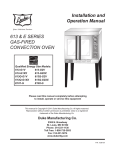
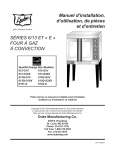
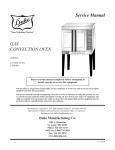
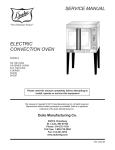
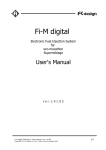
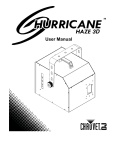
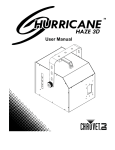
![MX2 sync [final].vp](http://vs1.manualzilla.com/store/data/005975841_1-4533d2555e3004ab9339335fb150c7a8-150x150.png)
